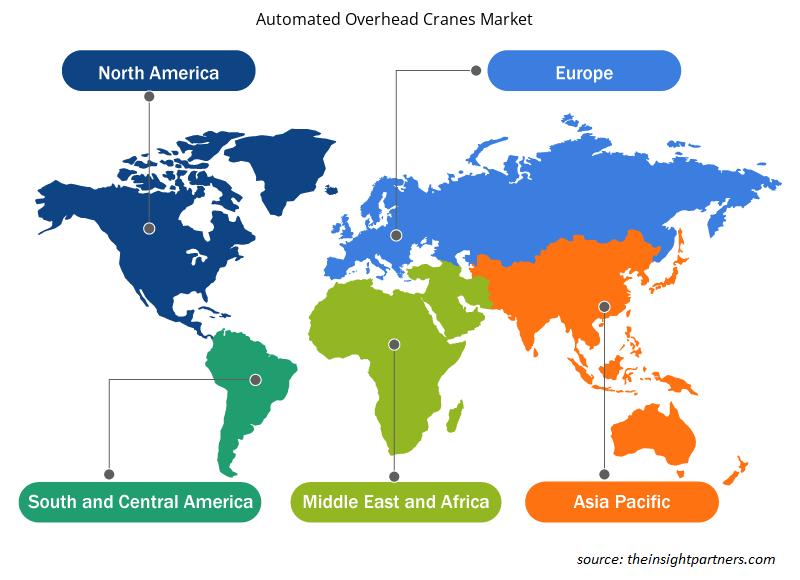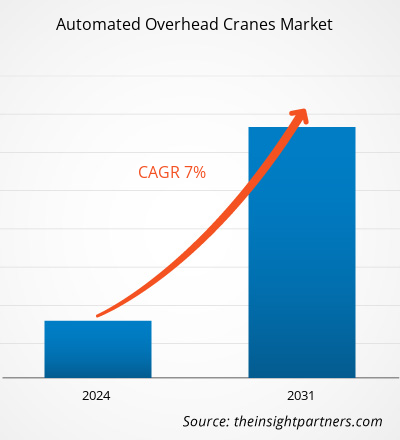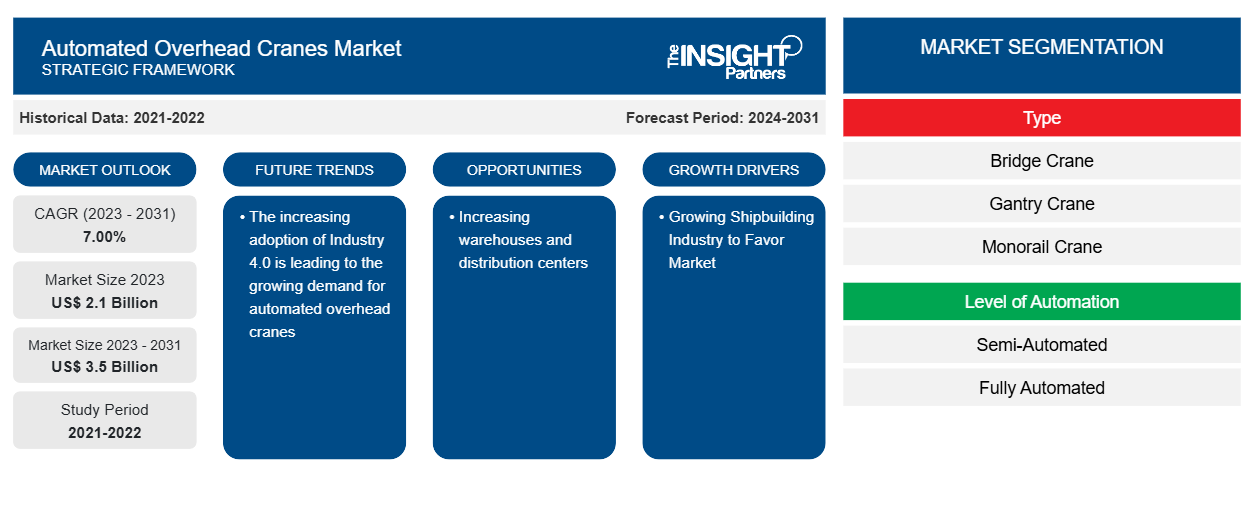Se proyecta que el tamaño del mercado de grúas aéreas automatizadas alcance los 3500 millones de dólares estadounidenses en 2031, frente a los 2100 millones de dólares estadounidenses en 2023. Se espera que el mercado registre una CAGR del 7,00 % durante el período 2023-2031. La creciente adopción de la Industria 4.0 está generando una creciente demanda de grúas aéreas automatizadas. Estas grúas se implementan además con tecnología inteligente que proporciona datos reveladores, lo que ayuda aún más en las operaciones efectivas de la tecnología de la Industria 4.0. Es probable que dicha adopción de la Industria 4.0 siga siendo una tendencia clave en el mercado.
Análisis del mercado de grúas aéreas automatizadas
Las partes interesadas en el mercado de grúas aéreas automatizadas incluyen proveedores de componentes de grúas aéreas automatizadas, fabricantes de grúas aéreas automatizadas y usuarios finales. La presencia de una gran cantidad de proveedores de componentes, incluidos marcos de carros , alambres/cables, ruedas de puentes, polipastos, rieles de pista y otros fabricantes, facilita que los fabricantes de grúas aéreas automatizadas satisfagan las demandas de sus respectivos clientes. Los proveedores de componentes de grúas aéreas automatizadas están ampliando sus capacidades de producción para satisfacer la creciente demanda de fabricantes de grúas aéreas automatizadas. Como los fabricantes de grúas aéreas automatizadas trabajan continuamente en sincronía con los proveedores de componentes y los usuarios finales, les ayuda a comprender las demandas de los usuarios finales y a desarrollar componentes avanzados. También tienen varios distribuidores repartidos en varios países y regiones, que también brindan soporte de servicio a los usuarios finales.
Descripción general del mercado de grúas aéreas automatizadas
Los actores de la industria son bastante escépticos acerca de invertir en soluciones automatizadas avanzadas que implican un alto CAPEX inicial y costos asociados con actualizaciones y mantenimiento constantes en la última parte debido a sus limitaciones presupuestarias. Las industrias que están adoptando grúas aéreas automatizadas exigen proveedores de soluciones bien capacitados y conocedores de antemano sobre las complejidades de sus implementaciones, como el costo asociado con la fabricación de grúas aéreas automatizadas y su renovación, mantenimiento, cargos por servicio, capacitación y consultoría, entre otros. Dado que estos son muy críticos para una empresa, incluso una pequeña escasez puede resultar en un impacto financiero significativo. Además, los propietarios de pequeñas y medianas empresas en diferentes verticales de la industria continúan restringiendo el crecimiento del mercado, debido a su presupuesto limitado para maquinaria industrial . Además, también se espera que el mercado sensible a los precios, como países seleccionados en Asia y regiones africanas, influya negativamente en la adopción de grúas aéreas automatizadas, debido a problemas presupuestarios y la falta de conciencia entre su personal industrial. Obstaculizando así el crecimiento del mercado de grúas aéreas automatizadas en todo el mundo.
Personalice este informe según sus necesidades
Obtendrá personalización en cualquier informe, sin cargo, incluidas partes de este informe o análisis a nivel de país, paquete de datos de Excel, así como también grandes ofertas y descuentos para empresas emergentes y universidades.
-
Obtenga las principales tendencias clave del mercado de este informe.Esta muestra GRATUITA incluirá análisis de datos, desde tendencias del mercado hasta estimaciones y pronósticos.
Impulsores y oportunidades del mercado de grúas aéreas automatizadas
Creciente industria de construcción naval favorecerá mercado
La industria de la construcción naval está creciendo debido al aumento del transporte marítimo. Según los datos publicados por la Administración Nacional Oceánica y Atmosférica en 2023, la construcción de barcos y embarcaciones ha experimentado una tasa de crecimiento del 15% con respecto a 2020. Además, la industria de construcción de barcos y embarcaciones de China completó la entrega de 38 millones de toneladas de peso muerto de barcos y embarcaciones, un crecimiento del 12% con respecto a 2022. Tal aumento en la industria de construcción de barcos y embarcaciones está generando una mayor demanda de grúas aéreas automatizadas, lo que en última instancia impulsa el mercado.
Aumento de almacenes y centros de distribución
Los minoristas electrónicos están cada vez más interesados en abrir almacenes en ciudades de nivel II y III. Por lo tanto, aumentará la demanda de grúas puente automatizadas en almacenes y centros de distribución para levantar equipos pesados y manipular materiales. La grúa de almacén generalmente consta de una grúa puente de una viga, una grúa puente de dos vigas y una grúa pórtico con polipasto eléctrico para fines de elevación. La mayoría de los almacenes y centros de distribución utilizan grúas puente automatizadas con una capacidad de elevación de 1 tonelada, 3 toneladas, 5 toneladas y 10 toneladas hasta 100 toneladas.
Análisis de segmentación del informe de mercado de grúas aéreas automatizadas
Los segmentos clave que contribuyeron a la derivación del análisis del mercado de grúas aéreas automatizadas son el tipo, el nivel de automatización y la industria.
- Según el tipo, el mercado de grúas aéreas automatizadas se divide en grúas puente, grúas pórtico, grúas monorraíl, grúas pluma y otras. El segmento de grúas puente tuvo una mayor participación de mercado en 2023.
- Por nivel de automatización, el mercado se segmenta en semiautomatizado y totalmente automatizado. El segmento semiautomatizado tuvo la mayor participación del mercado en 2023.
- En términos de industria, el mercado se divide en manufactura, construcción naval, metales y acero, entre otros. El segmento de manufactura tuvo una participación significativa del mercado en 2023.
Análisis de la cuota de mercado de grúas aéreas automatizadas por geografía
El alcance geográfico del informe de mercado de Grúas aéreas automatizadas se divide principalmente en cinco regiones: América del Norte, Asia Pacífico, Europa, Medio Oriente y África, y América del Sur y Central.
La región de Asia Pacífico dominó el mercado mundial de grúas aéreas automatizadas. Europa representó la segunda mayor participación de mercado. China se ha convertido en uno de los centros de fabricación a nivel mundial. Por lo tanto, el país se ha convertido en uno de los proveedores destacados de equipos de bajo costo. Además, la industria de la construcción naval ha experimentado un fuerte crecimiento en los últimos años, lo que genera aún más oportunidades lucrativas para el mercado.
Perspectivas regionales del mercado de grúas aéreas automatizadas
Los analistas de Insight Partners explicaron en detalle las tendencias y los factores regionales que influyen en el mercado de grúas aéreas automatizadas durante el período de pronóstico. Esta sección también analiza los segmentos y la geografía del mercado de grúas aéreas automatizadas en América del Norte, Europa, Asia Pacífico, Oriente Medio y África, y América del Sur y Central.

- Obtenga datos regionales específicos para el mercado de grúas aéreas automatizadas
Alcance del informe de mercado de grúas aéreas automatizadas
| Atributo del informe | Detalles |
|---|---|
| Tamaño del mercado en 2023 | 2.100 millones de dólares estadounidenses |
| Tamaño del mercado en 2031 | 3.500 millones de dólares estadounidenses |
| CAGR global (2023 - 2031) | 7,00% |
| Datos históricos | 2021-2022 |
| Período de pronóstico | 2024-2031 |
| Segmentos cubiertos |
Por tipo
|
| Regiones y países cubiertos |
América del norte
|
| Líderes del mercado y perfiles de empresas clave |
|
Densidad de actores del mercado: comprensión de su impacto en la dinámica empresarial
El mercado de grúas aéreas automatizadas está creciendo rápidamente, impulsado por la creciente demanda de los usuarios finales debido a factores como la evolución de las preferencias de los consumidores, los avances tecnológicos y una mayor conciencia de los beneficios del producto. A medida que aumenta la demanda, las empresas amplían sus ofertas, innovan para satisfacer las necesidades de los consumidores y aprovechan las tendencias emergentes, lo que impulsa aún más el crecimiento del mercado.
La densidad de actores del mercado se refiere a la distribución de las empresas o firmas que operan dentro de un mercado o industria en particular. Indica cuántos competidores (actores del mercado) están presentes en un espacio de mercado determinado en relación con su tamaño o valor total de mercado.
Las principales empresas que operan en el mercado de grúas aéreas automatizadas son:
- Sistemas automáticos
- Corporación Avon Barrier Ltd.
- CAME SpA
- Sistema de Houston Inc.
- LA BARRERA AUTOMÁTICA
- Sistemas de bolardos automatizados MACS
Descargo de responsabilidad : Las empresas enumeradas anteriormente no están clasificadas en ningún orden particular.

- Obtenga una descripción general de los principales actores clave del mercado de grúas aéreas automatizadas
Noticias y desarrollos recientes del mercado de grúas aéreas automatizadas
El mercado de grúas aéreas automatizadas se evalúa mediante la recopilación de datos cualitativos y cuantitativos posteriores a la investigación primaria y secundaria, que incluye publicaciones corporativas importantes, datos de asociaciones y bases de datos. A continuación, se enumeran algunos de los desarrollos en el mercado de grúas aéreas automatizadas:
- EMH ha lanzado grúas pórtico con patas semiabiertas. Estas grúas están diseñadas para transferir materiales entre las estaciones de trabajo. (Fuente: EMH, Newsletter, septiembre de 2023)
Informe de mercado sobre grúas aéreas automatizadas: cobertura y resultados
El informe “Tamaño y pronóstico del mercado de grúas aéreas automatizadas (2021-2031)” proporciona un análisis detallado del mercado que cubre las siguientes áreas:
- Tamaño del mercado de grúas aéreas automatizadas y pronóstico a nivel global, regional y nacional para todos los segmentos clave del mercado cubiertos bajo el alcance
- Tendencias del mercado de grúas aéreas automatizadas, así como dinámica del mercado, como impulsores, restricciones y oportunidades clave
- Análisis detallado de las cinco fuerzas de Porter y FODA
- Análisis del mercado de grúas aéreas automatizadas que cubre las tendencias clave del mercado, el marco global y regional, los principales actores, las regulaciones y los desarrollos recientes del mercado
- Panorama de la industria y análisis de la competencia que abarca la concentración del mercado, análisis de mapas de calor, actores destacados y desarrollos recientes para el mercado de grúas aéreas automatizadas
- Perfiles detallados de empresas
- Análisis histórico (2 años), año base, pronóstico (7 años) con CAGR
- Análisis PEST y FODA
- Tamaño del mercado, valor/volumen: global, regional y nacional
- Industria y panorama competitivo
- Conjunto de datos de Excel
Informes recientes
Testimonios
Razón para comprar
- Toma de decisiones informada
- Comprensión de la dinámica del mercado
- Análisis competitivo
- Información sobre clientes
- Pronósticos del mercado
- Mitigación de riesgos
- Planificación estratégica
- Justificación de la inversión
- Identificación de mercados emergentes
- Mejora de las estrategias de marketing
- Impulso de la eficiencia operativa
- Alineación con las tendencias regulatorias























 Obtenga una muestra gratuita para - Mercado de grúas aéreas automatizadas
Obtenga una muestra gratuita para - Mercado de grúas aéreas automatizadas